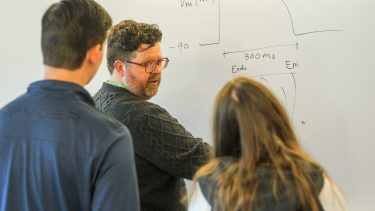Video by Sam Han | Text by Ignacio Lobos | UW-IT Communications & Engagement
In one of your commercial flights over the Cascade Mountains, between snacks, bathroom breaks and terrible romantic comedies, did you ever stop to think about the massive engineering feat that kept the engines running?
Have you ever considered your own engine — reliably ticking away year after year?
Patrick Boyle spends a lot of time thinking about the heart and the intricate electrical system that keeps it ticking along better than a Rolex ever could.
Boyle and his team in UW’s Cardiac Systems Simulation (CardSS) Lab in the Department of Bioengineering know the heart is an amazing workhorse, but they also know things go wrong.
That’s why they are using computational tools, machine learning, artificial intelligence and the power of Hyak, the UW’s supercomputer managed and operated by UW Information Technology (UW-IT), to spot electrical abnormalities before they turn into killing strokes.
“One of our areas of study is atrial fibrillation (AFib), an irregular heartbeat that causes the heart to beat too fast,” Boyle said. “It affects millions of people across the world, and it’s a terrifying disease.”
“It can be present, and your heart and body can tolerate the condition, and you may not know it at all,” he said. “For many people, the first sign there’s a problem is when they have a stroke.”
As its name implies, Boyle’s lab runs computational simulations of beating hearts to better predict and prevent electrical abnormalities. By studying heart rhythm disorders — specifically atrial and ventricular arrhythmias — the lab seeks to better understand why people suffer from heart disease and move health care technology forward.
Super heavy-duty computer users
An electrical abnormality is not an easy thing to track, much less predict. And that’s where the power of Hyak comes into play. It allows Boyle and his lab to run uninterrupted studies that can shed light on what’s making things go haywire.

His lab is also using many complex open-source packages maintained by the openCARP community, whose software and code is freely available for academic purposes; and powerful new tools created by numericor, which provides cutting-edge cardiac electrophysiology simulation solutions.
“We’re grateful to have amazing software tools to use in our work, and on-premises supercomputer to crunch the data,” he said. “We’re fortunate to have a resource like Hyak. For us, a single study has enough data to consume 3 to 4 million CPU hours. That’s an incredible amount of computing power,” he said.
And he needs every bit of it. He and his team are not studying one heart. They are studying thousands of electrical permutations in hundreds of hearts, all of them beating at their own rhythm and creating incredibly complex data points that add up to an incredible puzzle that the CardSS Lab can’t wait to crack.
